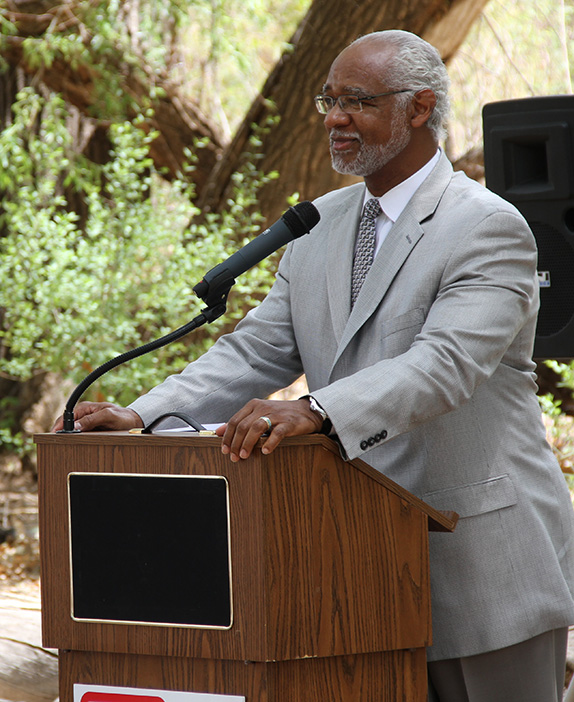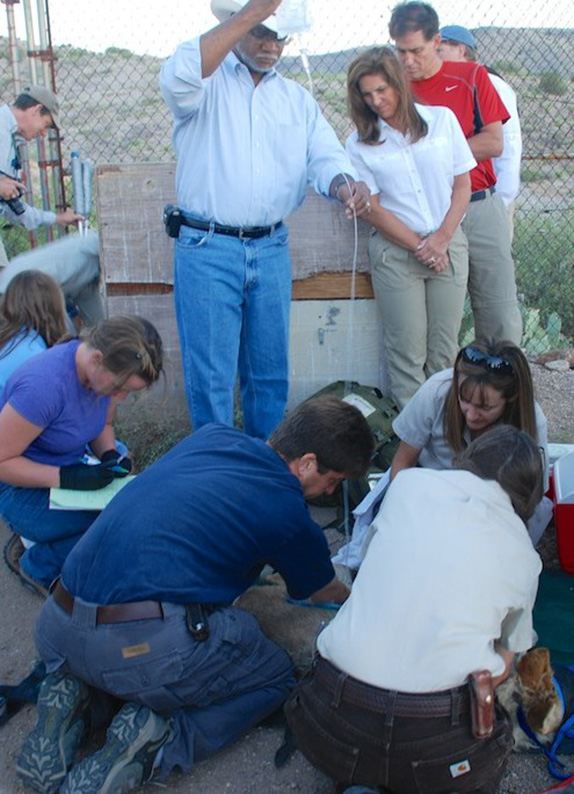Editor's note: This interview is part of the Utton Center's latest Environmental Flows Bulletin written by Laura Paskus.
Dr. Benjamin Tuggle is the southwest regional director of the U.S. Fish and Wildlife Service. Having arrived here seven years ago from Washington, D.C., where he was special assistant to the director, in the Southwest he has faced some of the most controversial endangered species issues in the nation—from the Mexican Gray Wolf reintroduction program to the near-extirpation of the silvery minnow in the Middle Rio Grande.
EFB’s Laura Paskus sat down with him at the end of April to talk minnows, water, and leadership. What follows are short excerpts from that interview.

(Dr. Tuggle recently accepted an Urban Waters Federal Partners designation recognition for the newly established urban refuge Valle de Oro National Wildlife Refuge in Albuquerque. Photo courtesy of USFWS.)
EFB: By default of protecting endangered species, and specifically endangered fish, the Fish and Wildlife Service has become the agency responsible for keeping water in the Southwest’s rivers. Is that a role that the agency should have? Is that a role you’re comfortable with?
Tuggle: We are very comfortable with that role. We often get accused, on either side, of being more of the regulatory agency because of our endangered species responsibilities, but I would like to think that we’re part of the solution. We’re part of the dialogue that needs to take place among all users, and we’re part of the picture that represents the species that can’t speak for themselves.
[In the course of managing water, there are many major principles and objectives involved.] We’re just one of them. We need to look out for the fish. We need to look out for our refuge. We need to look out for the riparian vegetation because of southwest willow flycatchers. We need to look out for those species that depend on those wet meadows, like the New Mexico jumping mice. But we’re just one voice. Reclamation has the responsibility of doing that management, and the maintenance and distribution, and things like that. So, when we’re talking to them, and we’re talking to Interstate Stream Commission, and we’re talking to MRGCD, our voice is one. And a lot of times, I think, unfairly, we get charged with being the one that’s driving the process.
Yes, we can drive the process, because we have a Biological Opinion that says, “Here’s what you should do,” but we still have to be part of the solution. We still have to be part of the management strategy that allows for the appropriate management of water in [that] stretch of the river.
EFB: I’ve oftentimes been surprised by what feels like a lack of leadership from the Fish and Wildlife Service within the Middle Rio Grande Endangered Species Act Collaborative Program. It seems like, for example, Fish and Wildlife Service should be leading the meeting, or that people should be listening to what Fish and Wildlife says to do because it’s an Endangered Species Act collaborative program….
Tuggle: But the key word is “collaborative.” That’s the key word; not “dictatorial.” It’s a collaborative. And so, there are a lot of people that have felt that way, that the Service should be leading this. And I’ve declined to do that, primarily because water management in this stretch of the river should not be about endangered species.
And if I was in charge, everybody would say, “Well, he’s in charge because of endangered species.” No. It’s about how we manage the water, and that’s why, when I tell you I’m one voice—a loud voice, sometimes—but I’m one voice. And it’s a collaborative process.
If we’re going to solve the problem of water in the Middle Rio Grande, it can’t be one agency that does it. It has to be all of us. And it can’t be one rule, like ESA, that dictates that. There has to be some give and take, because there’s only so much water. And the demand is always going to be greater.
Now, if you’re saying that you don’t feel that the collaborative has leadership, that’s a different thing. But I don’t feel that the Service should be necessarily leading it, because of ESA.
We have to be involved in it. There’s no question. I’m going to deviate just a minute. When I first got here, I went to a couple of collaborative meetings, and they kept talking about the endangered species. And I looked at them, and I said, “You know, this is more than endangered species. This is not about silvery minnow. Maybe you got the money, and you got the attention because of the calamity that might have happened because of the silvery minnow and the Biological Opinion, but that’s not what that’s about.” The collaborative gives us enough time, and enough resources, and enough cooperation to solve the problem—it’s not to make sure that we don’t run afoul of the Endangered Species Act. It’s much bigger than that.
If we only look at that through one lens, we’re missing one heck of an opportunity. I don’t have a problem stepping up when I should because everybody is very concerned about where we’re going to be—now that we’re writing a new Biological Opinion, and we have a Biological Opinion that we’re operating under until we get that done, and the fact that we’re going to be in one heck of a water year this year. And will we exceed the take? And that’s a conversation that we’re going to have to have with Reclamation and the Interstate Stream Commission and some of the other major players in this river. We will. We haven’t had it yet, but we will. And we’re going to have to find some solutions.
EFB: When you say solutions, do you mean for those two species, the silvery minnow and the flycatcher, or do you mean for everybody to function together in the system? Because my understanding is, the silvery minnow right now is doing as bad as it’s ever done.
Tuggle: Yes.
EFB: And most of the fish that are still alive are hatchery fish….
Tuggle: I would prefer [a solution for everybody] because it incorporates everybody’s portion of pain or gain, as long as we are talking about the solution that will allow for silvery minnows to exist in the river, to spawn in the river, to be sustainable in the river.
It would be easy for me to take a very selfish view of that, but I think that if I did, it would be very short-sighted, and I’d make probably more enemies than I would make collaborators.
We have to keep water in the river for the fish, or we have to come up with a Plan B in terms of where we will keep the river wet to sustain fish.
Most of the angst comes when [the river dries] from San Acacia south. We have a vested interest in trying to keep water there because that’s where most of the habitat is. And that also means that there’s more water that we can get to Bosque del Apache as well.
So, we’re looking at a lot of different options—in terms of if that has to happen if there’s not enough water—where we would do other habitat benefits things in the river where it’s wet for fish. And our folks are working on that. This is going to be a very difficult year, very difficult. I think people understand that. It’s going to be one whale of a challenge for the people who have to make those decisions.
Everybody’s not going to be happy, but I think that if we can get together and have the conversation about why we have made those management decisions and what it means to the future of all of those needs, then that’s going to be the best position we can be in.
I don’t have a crystal ball to tell you how that’s going to work out. I know that we will represent our responsibilities under ESA. I also know that we won’t get everything we want. And I’m very cautious, because I would like to have the opportunity to work that out locally, before somebody comes in with a legislative bomb and starts to dictate what the process is going to be, and it will be beyond the scope of the people who actually might have been able to work it out locally.
So, I don’t mean that bomb literally, but just taking it out of our hands. I think that that would be a mistake at this point. I think there’s enough good will among the agencies that are involved that we can talk frankly to one another and try to work this thing through. I may be wrong; don’t get me wrong. But I think that we can start from a good place.
And the reason why I say that is because—look at the San Juan, the collaborative operation that they have there. That’s what gives me faith that we can do it here. And the collaborative is moving very much to a Recovery Implementation Program. And it’s so difficult because just that switch, at a time when we have less water, is hard because it’s based on adaptive strategies. And now you’re trying to come up with a recovery implementation plan when drought is taking you down. And so, it would have been easier if we would have had a normal year, and then we would have been able to bracket what is normal.
So, we’re going to have to do a lot of work, in terms of looking at where that baseline is, as we talk about a recovery implementation plan. I don’t think the biology is going to change, but I think that there are things that we will have to look at, in terms of how we define that baseline of what the recovery goals actually are.
And it’s going to be some work; don’t get me wrong. Our folks are pragmatists in that regard. They know that they don’t have the full picture, but I’m still optimistic. I’m an optimistic kind of guy.

(Dr. Tuggle assisting in the prep of a Mexican Gray Wolf transfer. Photo by Laura Paskus.)
EFB: Does the Service have a long-term vision for what baseline is and how to even maintain baseline, never mind recovery?
Tuggle: That speaks to adaptive management as it relates to climate adaptation. If the baseline was X when you had lots of water in the ‘70s, the baseline can’t be X when you don’t have as much water in 2012.
We struggle with that because, is this climate change cyclical? Are we going to be able to come out of it, or is this the new normal? And so, it’s the argument about where the baseline should be for the 2003 Biological Opinion, and we are arguing about that vehemently because you don’t want to take a step back because the step back that you’re going to take means extirpation for the species in the river.
I don’t know if we could genuinely come up with an adaptive strategy at this time, during this time, for this stretch of the river. I think that we need to just try to survive right now.
We will develop those adaptive strategies when we figure out what a normal year might be, and we will continue to work in that direction. We know we have to get there. Boy, I tell you, we’re not in the operating room. We’re in the emergency room right now.
We are going to be more conservative because we don’t have time to have an objective to manage to. We’re just trying to keep them alive. We’re trying to keep this population from being extirpated. So, it’s a different conversation.
I would prefer the conversation under less demanding terms, but you’ve got the drought. You’ve got this potential of the new normal in terms of climate change. You have more people needing more water. And sooner or later this river is going to be adjudicated. It’s going to be a dog fight, lots of blood.
And I think that the compacts with the other states will be resolved, but, boy, we can’t wait on that. We have to do something in the next year to five years, to make sure that we just don’t have nothing in the river in terms of populations.
EFB: The Fish and Wildlife Service has a unique mandate. It also has many passionate people who are committed to their work and who see moral value in ensuring species don’t just disappear. What’s it like to lead an agency full of people who may feel that way?
Tuggle: Well, I’m extremely proud to be able to lead a group of people like that. It is very challenging, because that passion can be one-dimensional at times, and at times people don’t see the complete picture. I don’t have the luxury of wearing that passion on my sleeve, but it doesn’t mean it’s not there.
(Creative Commons feature images via Flickr. Wolves: Don Burkett, Silvery Minnows: JoelDeluxe)




Responses to “Striking a Balance”